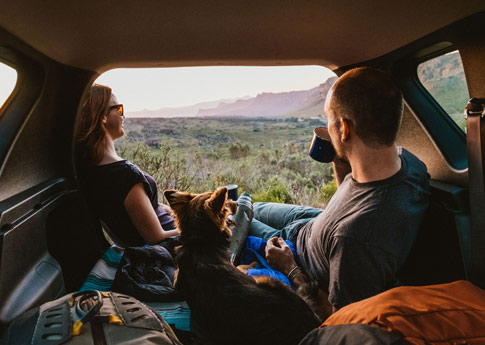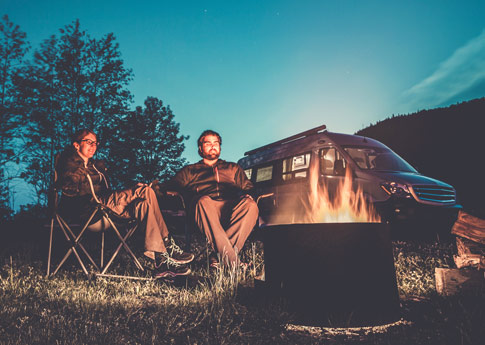Getting ready for a road trip

Gearing up to hit the highway in search of Quebec, Canada, or the U.S.A.? Proper planning will help you get the most out of the experience and preserve your peace of mind. Here’s a quick reminder of what to research and do before you set out so you can focus on fun and adventure along the way.
1. Pick a destination
The possibilities for road trips in North America are virtually limitless. Pick a destination according to your interests and needs (rest? escape?) and consider how many vacation days you have, how many kilometres you want to cover each day, and who’s going to come with you (significant other, friends, family, or whoever).
Heading stateside?
Canadians don’t need an international driving permit in the United States. Be sure to look up all the requirements for entering the United States by land, both for you and for anyone with you (by age). And while you’re at it, check how much worth of stuff you can bring back to Canada for the number of days you’ll be there.
2. Make a budget
Give yourself a budget for accommodations, meals, fuel, and things to do, both on the way and when you get there. Tip: set a little aside for the unexpected—a show you had no idea was even there, a restaurant somebody recommends or that calls out to you...
Good to know: CAA-Quebec members can get discounts at the big hotel chains and on gas purchases.
3. Plan your route
Planning an itinerary is the way to make the most of your time and detour around nasty surprises—or head head-on into nice ones! The TripTik® Travel Planner can suggest not just a route but also accommodations to go with it (reserve to avoid problems with availability), attractions, gas and charging stations, restaurants, and even price ranges for some of it all. The itinerary can be used online, printed out, or saved as a PDF.
All that planning will get you a personalized itinerary so you can explore spectacular scenic routes (U.S. secondary roads are often free, i.e., no toll plazas), remote villages, and under-the-radar points of interest. As rule, navigation apps, portable GPSs, and on-board systems start off by suggesting the shortest route, unless you change the settings.
Ticketed attractions on your itinerary? Remember to leave early so you don’t miss out if you’re held up in traffic (or at customs if you’re crossing the border—check wait times here).
Use navigation apps or GPS
Stay out of traffic jams with a navigation app (like: Google Maps, Waze, etc.) or your GPS if you’ve updated it. Upgrade your cellular data plan before you leave if necessary to avoid finding a massive bill waiting for you when you get home, or get a roaming plan that lets you use your navigation apps outside Canada.
Good to know: There are lots of apps that let you download maps for offline use. Your smartphone’s native map application (on iPhone it’s called “Maps”) can also direct you to your destination, usually with turn-by-turn voice instructions.
Follow the rules of the road on hand-held devices
The Highway Safety Code prohibits the use of display screens, cell phones, and on-board computers while driving for any purpose other than driving the vehicle. Find out how to use hands-free devices, your car’s Apple CarPlay or Android Auto system, and navigation apps safely before you leave. And of course follow the rules of the road and be courteous to other drivers.
Plan breaks for yourself along the way
Even if you don’t have kids with you, you should take a break every two hours, regardless of how far you’re going. Use breaks to stretch your legs, take a walk, doze, or have something to eat. Major roads generally have rest areas every so often, but if there aren’t any on your route, fast-food chains and service stations will do the job just fine.
Remember to include those break times when you plan your itinerary. They add to your travel time but are totally worth it for everyone in the vehicle.

Don’t try to stay awake
Be sure to get a good night’s sleep the night before you set off. If you start to feel sleepy, pull over in a designated safe rest area and take a short nap. Often a few minutes is enough to put you back in the driver’s seat.
4. Get your vehicle ready before hitting the road
Inspect your vehicle yourself
Long trips are tough on your vehicle. Avoid problems down the road by inspecting (and, if necessary, fixing) the following yourself before you leave:
- Windshield wipers
- Lights
- Tire pressure (including the spare)
- Fluid and lubricant levels
- The battery.
Get a professional mechanic to inspect your vehicle
Many garages and mechanics do custom inspections to help you get ready for a road trip. They’ll give you a report on whatever—engine, body, suspension, brakes, etc.—needs work.
Good to know: CAA-Quebec members get discounts and perks at CAA-Quebec Vehicle Inspection Centres and CAA-Quebec Approved Auto Repair Services.
5. Decide whether to rent a vehicle for your road trip
Most road trippers will want to use their own vehicle. Which is great if it’s in good shape, well maintained, and has enough space to comfortably carry all the passengers and their stuff. But if you’d like to explore other options, here are two:
Rent a vehicle
Rather not put hundreds or even thousands of kilometres on your odometer in a matter of days or weeks? Renting may be the answer. Be sure to take a good look at the terms and conditions, including vehicle pickup and dropoff procedures.
Good to know: CAA-Quebec members get discounts and benefits when they rent with Enterprise, National, and Alamo.
Rent an RV
A road trip is an ideal opportunity to try an RV by renting one to find out if it works for you before you rush out and buy a trailer or motorhome, for instance. And check out our tips on choosing, using, and driving an RV so you can get the most out of the experience.
6. Consider comfort and entertainment on the road
Bring snacks and drinks for the road
Drink plenty of water, especially in the summer. Keep a bottle of water within reach. If you’re behind the wheel, stick to snacks and light meals en route (linked article in French). Everyone else can munch as the mood strikes them (bring wipes for little hands).
Bring some on-board entertainment
Riding in a car can become monotonous. Electronic entertainment (such as films, shows, and games on phones or tablets) can keep passengers occupied for a while, but it’s always good to have other tricks up your sleeve. Make up some car games, listen to music, sing, read, or whip out the colouring books and crayons. But be careful—the entertainment can’t distract the driver.
How about some tunes?
Download music files on your portable devices or USB drive, use a streaming service, get satellite radio, or tune in to your favourite radio station. But avoid distracted driving by getting your device or vehicle infotainment system set up in advance using CAA-Quebec’s UPP method. And check out our “Road Trip with CAA-Quebec” playlist on Spotify.
7. What to do if you run into problems along the way
Never hit the road for any kind of trip (long or short) without a first-aid kit and an emergency kit (including jumper cables). And there are some other kinds of protection you might need.
Out-of-province insurance
The moment you step outside the province, the rules for insurance, accidents, and liability change. Make sure you’re properly covered if you get injured or sick where you’re going and that you have the right car insurance if you get in an accident. The contents of your vehicle should be covered by your home insurance. Cancellation insurance is also worth a look in case something comes up that forces you to head home early.

Roadside assistance
As a CAA-Quebec member, your roadside assistance covers you, not your vehicle. That means you get all your roadside assistance services even if you’re a passenger in someone else’s vehicle. Membership entitles you to 24/7 roadside assistance anywhere in Canada and the U.S. Check your plan before you leave to make sure you’ll get the help you need if the vehicle you’re in has a flat tire, mechanical failure, or accident.
Take advantage of your travel insurance on trips, on vacation—and at home!
The CAA-Quebec Travel Insurance Annual Plan option is perfect for your summer vacation and future travel! It covers you while you’re abroad, while also offering a host of “local” benefits.
- At home: 4 free virtual emergency medical assistance (telemedicine) services so you can talk to a doctor from the comfort of your living room
- Vacations in Quebec: Reimbursement of emergency medical costs such as ambulance or emergency dental care fees
- Canada getaways: You’re insured for all Canadian travel, with no maximum duration
Need advice regarding your vehicle or want to upgrade your membership?

Benefit from personalized advice
Electric or gas-powered cars, RVs, ATVs or motorcycles
Enhance your experience
Switch to the card that best suits your needs.